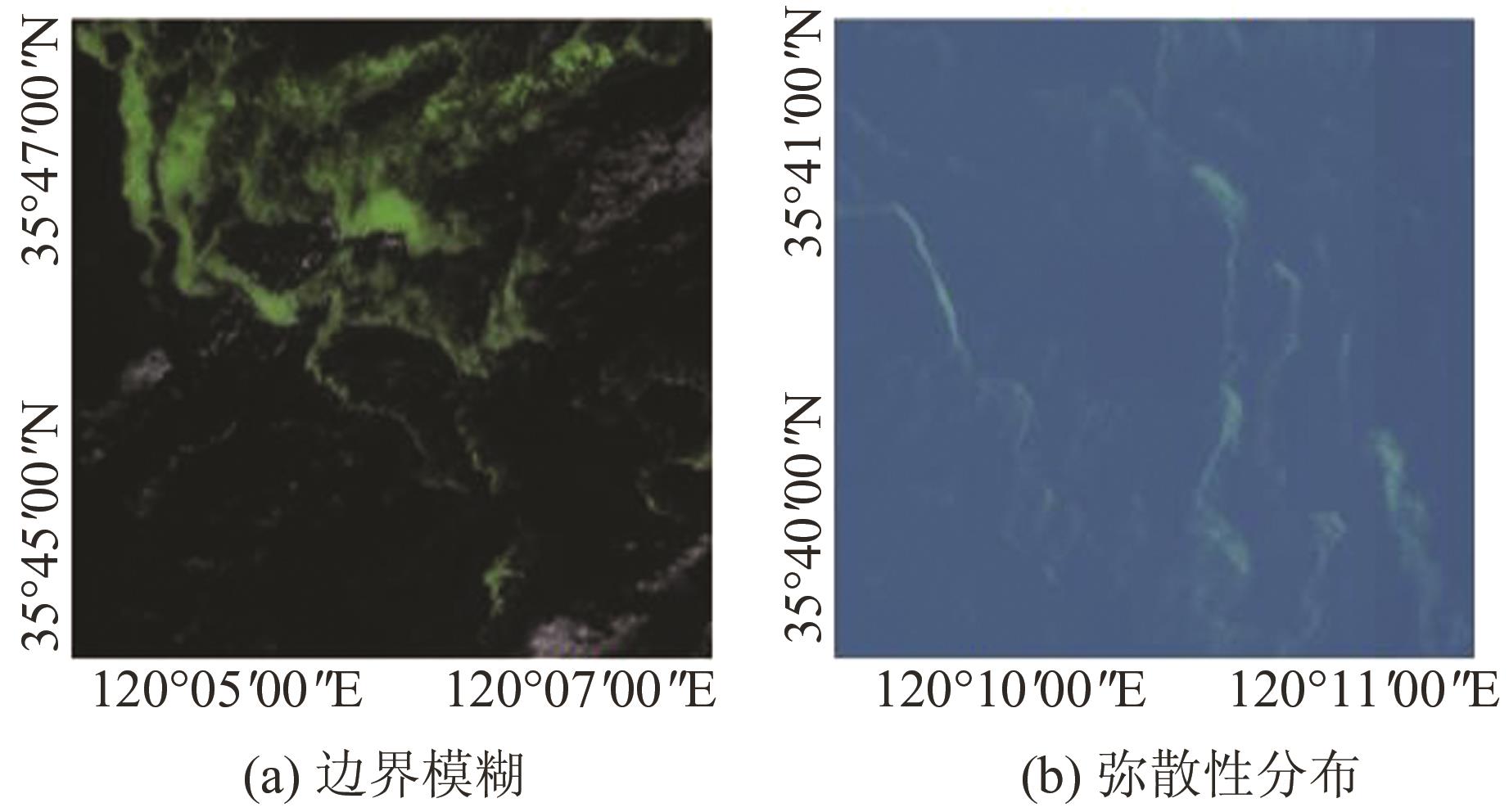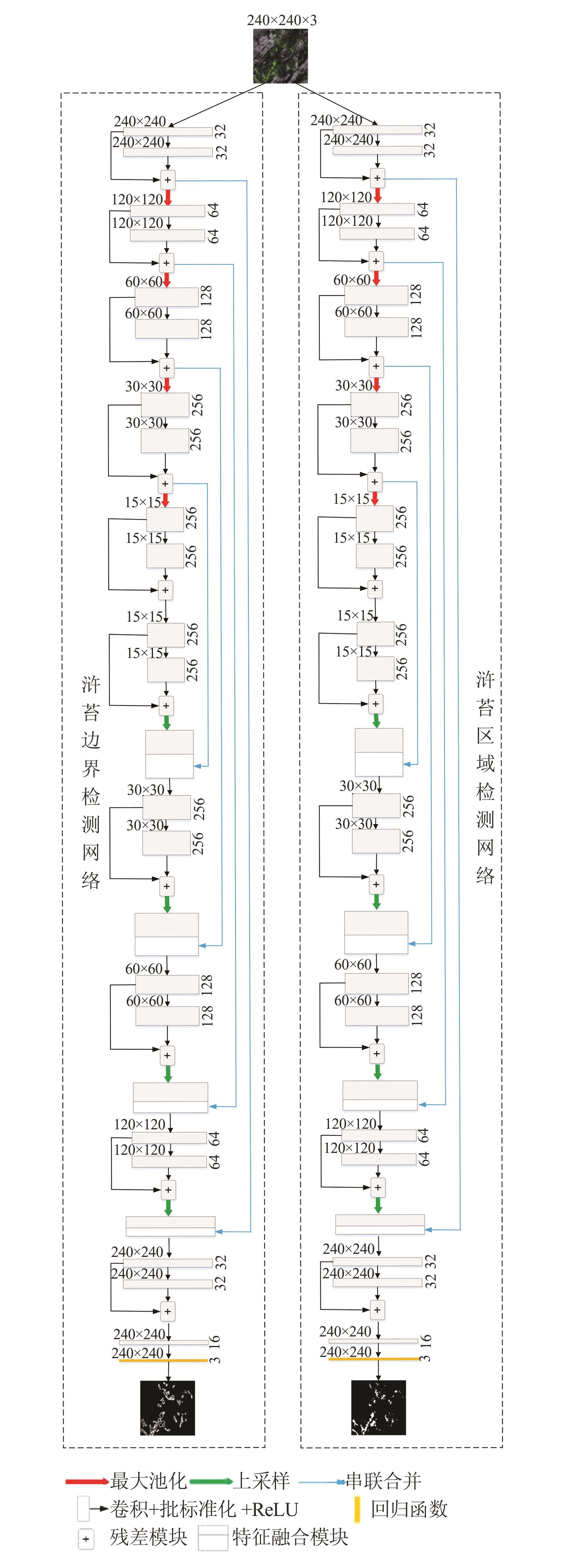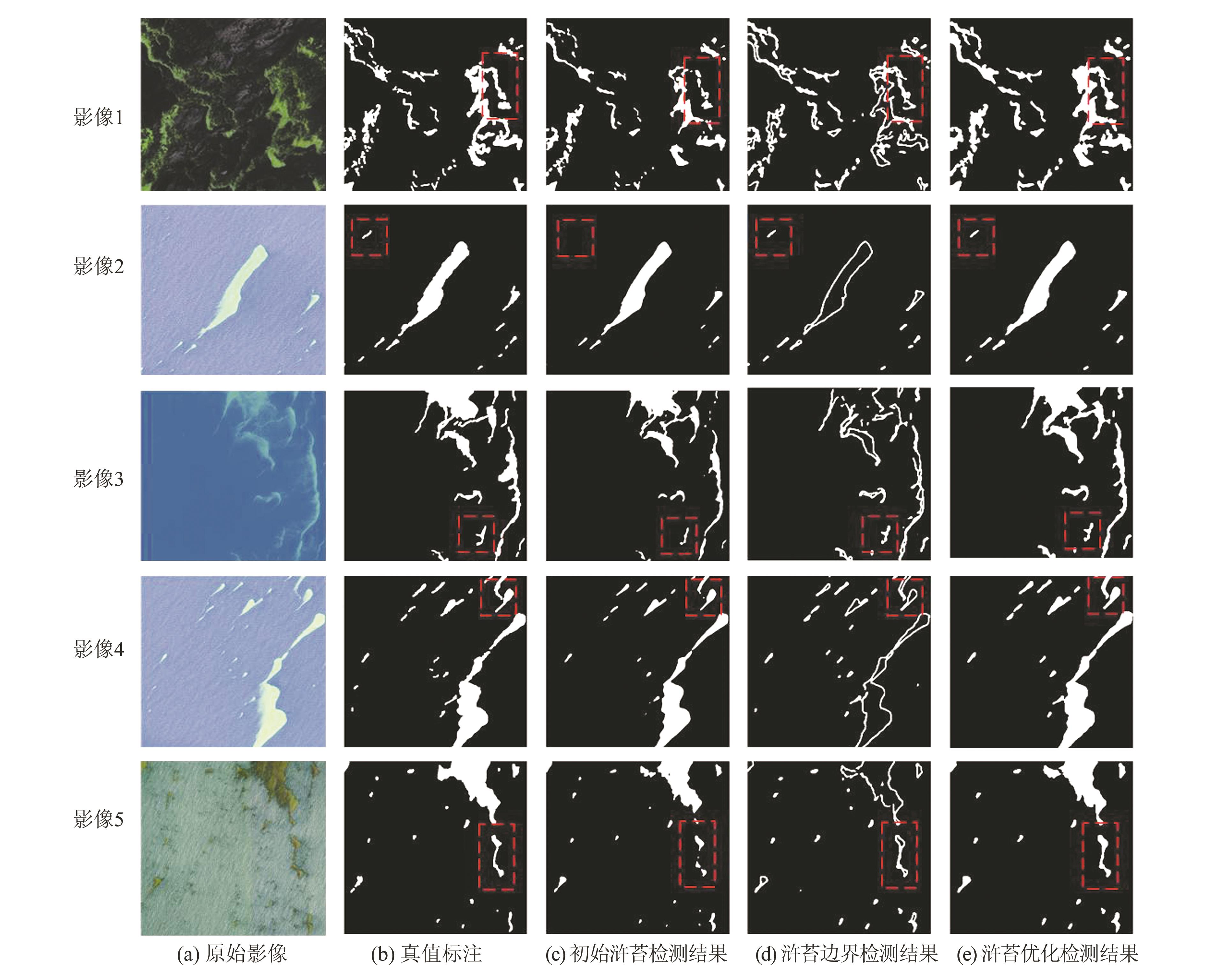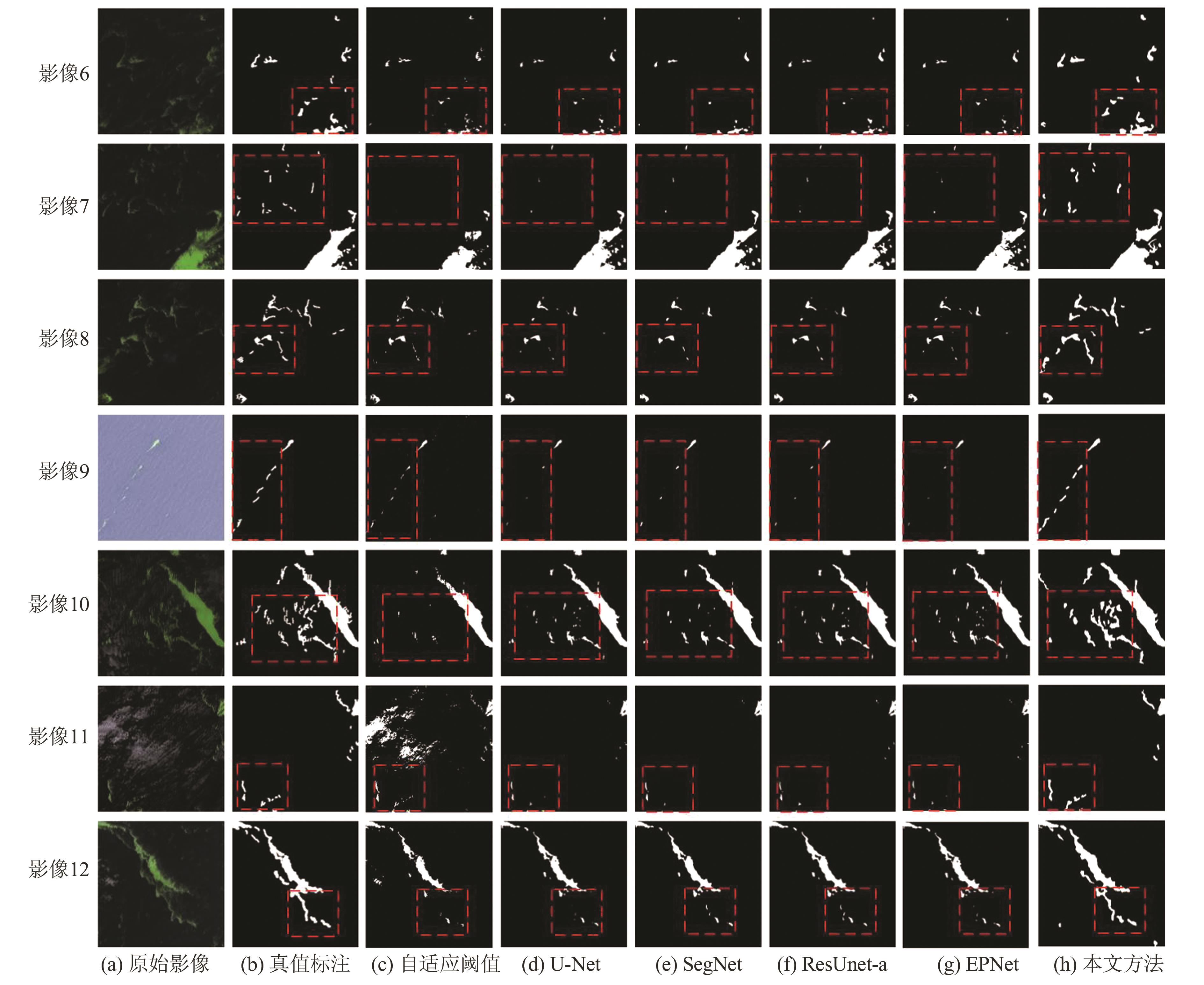Ulva polifera Detection from High Resolution Remote Sensing Images Based on Dual-Path Convolutional Neural Networks
-
摘要:
浒苔绿潮是一种危害巨大的海洋生态灾害。如何快速准确地检测出浒苔,对其及时治理和促进海洋产业健康发展具有重要意义。针对高分辨率遥感影像浒苔检测中浒苔区域边界难以精确确定的问题,提出一种基于双路卷积神经网络的高分辨率遥感影像浒苔检测方法。首先,基于高分辨率遥感影像中浒苔分布特性,设计了一种双路卷积神经网络语义分割架构,用于提取影像中浒苔区域和边界等属性特征;然后,提出一种基于浒苔边界辅助优化浒苔区域检测结果策略,对初始浒苔检测结果优化处理获得精确浒苔区域检测结果;最后,进行定性对比实验和定量评价。结果表明,所提方法对高分辨率遥感影像浒苔检测结果的F1分数、交并比和整体分类精度分别为88.25%、78.97%、98.99%,能够实现对不同类型的浒苔精确检测,获得良好的高分辨率遥感影像浒苔检测结果。
Abstract:ObjectivesThe green tide formed by Ulva prolifera (U. prolifera) is a harmful marine ecological disaster. The rapid and accurate detection is of great significance for timely management of U. prolifera and the healthy development of the marine industry.
MethodsBecause the boundary of U. prolifera area is difficult to be determined accurately in high resolution remote sensing images (HSRIs), an U. prolifera detection method for HSRIs based on dual-path convolutional neural networks (CNN) is proposed in this paper. First, a dual-path CNN semantic segmentation framework is designed based on the distribution characteristics of U. prolifera in HSRIs. The area and boundary of U. prolifera in HSRIs can be extracted simultaneously using the proposed framework. Then, the strategy for optimizing the initial U. prolifera area detection results based on U. prolifera boundary is proposed to improve the detection accuracy.
ResultsThe experimental results show that the proposed method can extract U. prolifera accurately, with F1-score of 88.25%, intersection-over-union of 78.97% and over accuracy of 98.99%, which is better than other U. prolifera detection algorithms.
ConclusionsThe proposed method can obtain good results for the detection of different types of U. prolifera in HSRIs.
-
卫星精密轨道确定中光压建模一直是一个重要研究课题。GPS卫星导航系统是目前力学机理模型较为清楚的导航系统,其定轨精度从最初的米级提高到现在的厘米级,很大一部分得益于光压模型的不断的精化[2]。北斗卫星导航系统(BeiDou Navigation Satellite System, BDS)是中国自主研制的卫星导航系统,与其他导航系统相比,中国的BDS系统由GEO、IGSO、MEO三类卫星组成,目前BDS卫星定轨精度尚没有达到GPS那样的定轨精度,一个很大的原因就是没有建立适合这三类卫星的光压模型,因此应该根据这三类卫星的轨道、姿态、物理特性建立不同的光压模型,以期提高这三类卫星定轨的精度。
回顾GPS光压模型建模的历程,一般分为分析型光压模型、经验型光压模型、半分析半经验型光压模型。分析型光压模型主要有ROCK模型[3]、T10/T20/T30模型[4];经验型光压模型有Colombo模型[5]、JPL使用的GSPM(GPS solar pressure model)模型[6]、CODE建立的ECOM模型、BERNE1、BERNE2[2, 7];半分析型半经验型光压模型有Adjustable box-wing模型[8]。Bernese ECOM光压模型是CODE针对GPS卫星建立的经验型光压模型,该模型是目前IGS几大分析中心定轨软件中使用最多、定轨效果较好的光压模型。该模型认为太阳是引起轨道共振的激发源,因此与Colombo模型的RTN方向不同,ECOM模型在DYB坐标轴下,采用3个相互正交方向上分别使用3组参数(共9个参数)来吸收残余摄动力影响,可使定轨精度达到厘米级。但是由于该模型吸收了其他一些未能建模的摄动力,其模型的意义已不再是单纯的光压摄动,更确切的是将物理机理不清楚的力学因素用9参数函数模型来表达,因参数的时效性有限,定轨时需分段逼近。但是该模型包含的估计参数较多,由于定轨参数间的相关性,并非解算全部9参数会得到最优解,故结合每个参数的贡献大小和显著性水平寻求最佳的参数组合,以期提高卫星定轨精度。对于GPS卫星定轨,目前普遍认为定轨效果比较好的办法是只解算D、Y、B轴上长期项D0、Y0、B0和B轴上的周期项Bc、Bs共5个参数,武汉大学PANDA软件中采用的就是这样的方式[9-11],但是这只是经验上的设定,并没有文献通过理论上的分析去说明,甚至是否还有更优的参数解算方式,这都是值得研究的。另外,ECOM模型是针对GPS卫星建立的,GPS全部是由MEO卫星组成,该模型用到BDS上未必合适,比如BDS中GEO采用零偏航的姿态控制模式,这与ECOM模型的建立方式有偏差,因此也应该进行相关的研究。
文献[12]使用了GPS的SP3精密星历,对GPS卫星的ECOM光压模型参数进行了统计分析,对于GPS卫星定轨估计8个参数较为合理。文献[2]基于历史的GPS精密星历研究了光压参数的变化规律,并将其中的一部分参数固定,形成了新的光压模型CODE98,该模型特别适合GPS卫星快速定轨和预报。这两种方法为BDS光压模型的研究提供了思路,但也存在些问题, 如文献[13]研究采用了轨道拟合的方式,而用实测L波段的载波和相位观测数据进行定轨时,定轨的观测方程与轨道拟合的观测方程形式不同,轨道拟合时的设计矩阵A和B实际为状态转移矩阵Φ和敏感矩阵S,而采用L波段的观测数据定轨时观测方程中的设计矩阵还需乘上测站至卫星方向的3个方向余弦,因此仅靠轨道拟合方式得到的光压参数组合在采用实测L波段数据定轨时并不一定是效果最佳的;而CODE98将一部分参数固定,实际定轨时这部分参数的不确定度很可能会被其他参数吸收,参数也失去了原来的意义。而且这两种方式都是针对GPS卫星的,因此本文借鉴这两种处理方式,分析ECOM模型在BDS定轨中参数最佳的组合方式。将一年的BDS精密星历作为观测量进行轨道拟合,对拟合得到的9个参数时间序列进行分析,研究参数的量级以及变化规律,结合参数相关性分析结果,构建线性回归参数显著性假设,最终确定出参数的最佳组合方式,最后利用MGEX实测数据进行定轨,轨道和钟差比较结果表明,只解算D0、Y0、B0、Bc、Bs共5个参数定轨效果最佳。
1 ECOM光压模型
ECOM光压模型定义eD、ey、eB作为3个基本坐标单位向量,eD为卫星至太阳方向单位向量,正向指向太阳,ey为卫星至地心方向的单位向量,eB为卫星太阳帆板轴向单位向量,ex、ey, ez为星固坐标系坐标轴的单位向量,有ey=ez×eD,ex=ey×ez,eB=eD×ey[8]。
ECOM模型加速度计算公式如下:
$$ \begin{array}{l} \mathit{\boldsymbol{a}}{_s} = \frac{{a_u^2}}{{|\mathit{\boldsymbol{r}}{_s} - \mathit{\boldsymbol{r}}{|^2}}}\left[ {D\left( u \right) \cdot \mathit{\boldsymbol{e}}{_D} + Y\left( u \right)\cdot{\rm{ }}\mathit{\boldsymbol{e}}{_y} + } \right.\\ \left. {B\left( u \right)\cdot{\rm{ }}\mathit{\boldsymbol{e}}{_B}} \right] \end{array} $$ (1) 其中
$$ \begin{array}{l} D\left( u \right) = {D_0}\left[ {\lambda {\rm{SRP}}\left( 1 \right)} \right. + {\rm{SRP}}\left( {\rm{4}} \right) \cdot \cos \left( u \right) + \\ \left. {{\rm{SRP}}\left( 5 \right) \cdot \sin \left( u \right)} \right] \end{array} $$ (2) $$ \begin{array}{l} Y\left( u \right) = {D_0}\left[ {{\rm{SRP}}\left( 2 \right)} \right. + {\rm{SRP}}\left( 6 \right) \cdot \cos \left( u \right) + \\ \left. {{\rm{SRP}}\left( 7 \right) \cdot \sin \left( u \right)} \right] \end{array} $$ (3) $$ \begin{array}{l} B\left( u \right) = {D_0}\left[ {{\rm{SRP}}\left( 3 \right)} \right. + {\rm{SRP}}\left( 8 \right) \cdot \cos \left( u \right) + \\ \left. {{\rm{SRP}}\left( 9 \right) \cdot \sin \left( u \right)} \right] \end{array} $$ (4) 式中,SRP(i)(i=1, 2, …, 9)为待估参数;u定义为卫星在轨道平面上距升交点的角度;λ为阴影因子;αu代表天文单位的长度;rs、r分别为惯性系下太阳和卫星的位置;D0为与卫星型号有关的面质比参数,其取值与卫星型号以及质量有关。
2 BDS光压参数相关性分析
线性化后的定轨观测方程可写为:
$$ \mathit{\boldsymbol{AX + BY + \boldsymbol{\varDelta} = L}} $$ (5) 其中,X为定轨基本参数,即系统参数;Y为附加参数;Δ为观测误差;L为观测量。参数相关性分析时X为6个轨道根数,而Y为ECOM模型的9个光压参数。
对光压模型参数的相关性检核的具体方法如下:使用2014年的GFZ解算的BDS星历作为伪观测值,选择6个轨道根数及9个光压参数作为解算参数,形成观测方程并得到权逆阵,并按式(6)计算相关系数:
$$ {p_{ij}} = {q_{ij}}/\left( {\sqrt {{q_i}{q_j}} } \right) $$ (6) 式中,qij为权逆阵第i行第j列元素;qi、qj为权逆阵对角线第i、j元素。统计每天每颗卫星解算的相关系数大于0.80的参数对,一年中超过30 d都相关的参数对情况如表 1。
表 1 BDS定轨中ECOM模型9参数相关性分析Table 1. Correlation Analysis of Nine Parameters of ECOM in BDS POD卫星号 参数1 参数2 所有卫星C01-C14 D0 Dc D0 Ds Ys Bc Bs Yc C02、C03、C10、C11、C12、C13、C14 Y0 Yc C03、C05、C06、C08、C09、C10、C11、C12、C13、C14 Y0 Ys 以C03卫星为例,解算出来的相关系数一年的变化情况如图 1,其他卫星与此类似。
从表 1中看出,所有卫星D0参数与Dc和Ds强相关,而Ys与Bc、Bs与Yc强相关;除了C01、C02、C04、C07卫星外,其他卫星Y0与Ys强相关;而对于GEO和MEO卫星Y0与Yc参数强相关,对于IGSO卫星则相关性较弱。
其中,D0参数代表对日方向的加速度,所以D0参数是必须解算的,Dc、Ds参数就不需要解算,对于其他4个参数Yc、Ys、Bc、Bs是否解算,需要进行参数的显著性检验,与文献[13]的处理方式不同,因为实测数据定轨时的法方程与轨道拟合的法方程不同,故本文除了通过统计检验的方式进行参数的显著性分析,还对这4个参数一年的时间序列进行分析,从参数的量级以及参数的年变化规律分析参数可解与参数不需要解算的情况。
3 光压参数的周年特性分析与显著性检验
3.1 参数周年特性分析
以C01卫星为例,Y0、Yc、Ys、Bc、Bs参数一周年的序列值如图 2。
图 2中方框内的时期为地影期,这时间段内的光压参数是不稳定的,剔除这两段时期的数据进行统计,可以看出Bc、Bs参数存在一个以年为单位的周期项,而且Bc、Bs参数的量级要比Y0、Yc、Ys参数的大,这5个参数的均值mean和均方根RMS如表 2。
表 2 C01卫星5参数的均值和均方根/(10-9m·s-2)Table 2. The Mean and RMS of 5 Parameters of Satellite C01/(10-9m·s-2)参数 Y0 Yc Ys Bc Bs mean -0.221 -0.157 -0.145 -0.448 -0.107 RMS 0.862 0.892 0.924 5.371 3.846 为了分析Bc、Bs参数的周期特性,下面采用快速傅里叶变换对Bc、Bs参数周期进行分析,详细步骤如下:
1) 数据预处理,对剔除的粗差点进行插值处理,得到等间隔的参数时间序列;
2) 利用谱分析方法对数据进行分析,得到频谱图;
3) 选择最大周期,对光压序列进行拟合,拟合的结果与原始的序列如图 3、图 4。
3.2 参数的显著性检验
参数的显著性检验采用文献[13]的方式进行,通过不同类型参数定轨结果方差比的F检验方法来实现。
构造原始假设H0:σ02=σ12
备选假设H1:σ02 < σ12
实际计算中σ02取为9参数模型计算得到的单位权中误差,即σ02=VTPV/t,t为多余观测数;V为采用9参数模型定轨得到的观测量验后残差;σ12=(V1TPV1-VTPV)/t0,其中t0为待检核的参数数量,比如仅仅要检核光压参数SRP(i),则t0=8;V1为不估计检核参数SRP(i)得到的残差。若统计量σ12/σ02大于由给定显著水平及子样容量确定的F分布积分上限,则说明这些参数是显著的,应该在模型中体现,否则说明该参数在定轨中可不估计。
采用上节GFZ解算的一年的精密星历作为伪观测量,每天一个弧段依次对Yc、Ys、Bc、Bs共4个参数进行显著性检验,给定显著性水平0.05,得到F0.05(1, 270)=3.880,则方差比超过该值就认为该参数是显著的,统计4个参数这一年中通过显著性检验的比率,见表 3。
表 3 14颗卫星4个参数显著性检验通过的比率/%Table 3. Passing Rate of 4 Parameters Significance Test of 14 Satellites/%Yc Ys Bc Bs C01 20.14 24.73 43.11 47.35 C02 4.53 5.66 28.68 24.53 C03 7.43 11.52 29.74 29.74 C04 18.84 18.49 40.75 34.59 C05 9.84 8.85 30.16 30.16 C06 24.84 22.93 47.13 39.81 C07 22.68 24.28 40.58 52.40 C08 19.86 21.63 37.59 41.13 C09 27.94 30.79 47.62 43.81 C10 27.16 28.75 41.85 42.17 C11 24.48 23.22 62.15 60.25 C12 22.27 20.06 55.52 54.89 C13 26.10 23.66 65.85 58.54 C14 24.75 22.85 66.46 60.13 从表 3中看出,Bc、Bs参数通过检验的比率明显大于Yc、Ys参数,而且GEO卫星更明显,这说明Yc、Ys的显著性较弱,为了检验不解算Yc、Ys参数的定轨效果,与文献[12]的方式不同,本文采用L波段实测数据定轨来验证。
4 实测数据定轨结果分析
收集了2014年年积日069-079期间共50个MGEX监测站的数据进行定轨,测站分布如图 5,设计3种不同的参数解算方案:
方案1 解算D0、Dc、Ds、Y0、Yc、Ys、B0、Bc、Bs;
方案2 仅解算D0、Y0、Yc、Ys、B0、Bc、Bs;
方案3 仅解算D0、Y0、B0、Bc、Bs。
定轨采用的模型和参数如下:观测量采用B1、B2频点无电离层组合伪距和相位非差观测量;解算弧段为3 d,采样间隔为300 s;截止高度角7°;EOP参数固定为IERS C04值;模糊度采用浮点解;跟踪站坐标固定为GPS PPP结果;测站潮汐改正考虑地球固体潮、固体极潮、海洋极潮、测站海潮;对流层采用Saastamoinen + GMF估计湿延迟参数。
在定轨解算过程中,考虑的摄动力模型包括以下几项:JPL DE405太阳、行星摄动,EGM96 10×10阶重力场模型,IERS-Conventions 2010地球固体潮、海潮、地球极潮、海洋极潮,积分器采用的是RKF6/7起步、Adams预报校正多步法。
采用内符和外符两种方式评估3种方案的定轨结果:①重叠弧段比较;②与GFZ结果进行比较。
4.1 重叠弧段比较结果
统计3种方案10 d定轨结果,采用3 d重叠2 d的方式评估3种方案的定轨精度,比如“069-070-071”和“071-072-073”两个3 d弧段,统计重叠071天的结果,10 d共重叠第7 d,给出7 d的平均值,分别采用径向和用户距离误差(user range error, URE)衡量3种方案的定轨精度。URE是卫星轨道误差在全球范围内用户观测方向上投影的平均值,表征了导航卫星轨道误差对用户测距的影响[15],计算公式为:
$$ \begin{array}{l} {\rm{UR}}{{\rm{E}}_{{\rm{BDS(GEO,IGSO)}}}} = \\ \sqrt {{{\left( {0.99\Delta R} \right)}^2} + \frac{1}{{127}}(\Delta {T^2} + \Delta {N^2})} \end{array} $$ $$ \begin{array}{l} {\rm{UR}}{{\rm{E}}_{{\rm{BDS(MEO)}}}} = \\ \sqrt {{{\left( {0.98\Delta R} \right)}^2} + \frac{1}{{54}}(\Delta {T^2} + \Delta {N^2})} \end{array} $$ 式中,ΔR、ΔT、ΔN分别为卫星轨道在R、T、N方向上的误差。
重叠弧段比较结果如图 6,可以看出:无论是径向还是URE,方案3的定轨精度都是最佳,方案3相对方案1径向提高72.9%,URE提高58.6%。
4.2 与GFZ结果比较
统计3种方案10 d定轨结果,将结果与GFZ解算结果进行比较,GFZ目前提供了多系统星历产品的解算策略[15],10 d的平均值结果如表 4。可以看出:对于GEO卫星,方案3中R、N两个方向精度明显高于方案2,但是T方向的精度最差,这与文献[11]的结果一致,文献[11]采用切向经验力补偿了GEO卫星切向残余的摄动力,提高了GEO卫星定轨的切向精度[11];对于IGSO/MEO卫星,在R、T、N方向上方案3的定轨结果都是最佳的,IGSO卫星方案3相对于方案1,3个方向分别提高82.92%、17.70%、31.86%,MEO卫星方案3相对于方案1,3个方向分别提高61.02%、15.30%、25.84%。
表 4 3种方案定轨精度比较结果/mTable 4. POD Accuracy Comparison of Different Schemes/m方案1 方案2 方案3 R T N R T N R T N C01 0.505 5.260 0.516 0.348 7.634 0.457 0.266 8.798 0.301 C03 1.030 5.084 0.324 0.205 5.831 0.246 0.161 5.427 0.153 C04 0.644 1.813 0.396 0.630 2.931 0.389 0.466 2.588 0.145 C05 0.739 3.573 0.374 0.263 4.160 0.236 0.191 4.095 0.198 mean 0.730 3.933 0.403 0.362 5.139 0.332 0.271 5.227 0.199 C06 0.892 0.634 0.340 0.217 0.635 0.303 0.141 0.575 0.275 C07 0.564 0.512 0.379 0.173 0.462 0.337 0.107 0.367 0.222 C08 1.791 0.509 0.379 0.395 0.468 0.364 0.235 0.490 0.255 C09 0.861 0.592 0.285 0.270 0.669 0.248 0.196 0.587 0.190 C10 0.782 0.492 0.311 0.234 0.275 0.257 0.154 0.238 0.212 mean 0.978 0.548 0.339 0.258 0.502 0.302 0.167 0.451 0.231 C11 0.294 0.284 0.241 0.112 0.278 0.212 0.098 0.302 0.213 C12 0.259 0.348 0.219 0.125 0.310 0.169 0.100 0.283 0.193 C13 0.211 0.294 0.340 0.132 0.276 0.304 0.104 0.248 0.204 C14 0.253 0.330 0.268 0.112 0.261 0.244 0.094 0.231 0.180 mean 0.254 0.314 0.267 0.120 0.281 0.232 0.099 0.266 0.198 比较3种方案10 d定轨解算的钟差结果,比较时需要消除两家定轨结果中不同的钟差基准影响,通常采用所谓的“二次差”法[13],本文选择C01卫星作为参考星,然后其他卫星计算的钟差结果相对C01卫星的钟差做一次差,并将消除了基准钟差影响的计算结果之间做二次差,统计其他卫星的RMS值,结果如图 7。
从图 7的结果可以看出,方案3的钟差之差的均值为0.31 ns,方案2的钟差之差的均值为0.51 ns,方案1的钟差之差的均值为1.86 ns,方案3的结果最好,这与轨道的评估结果一致。
5 结语
BDS卫星精密定轨中应用最多的经验型光压模型是ECOM模型,但是该模型解算参数较多,不一定解算全部参数定轨效果最佳,因此本文针对ECOM模型在BDS定轨中的应用特性,分析参数的特性,寻求最佳的参数组合方式,以期提高BDS卫星精密定轨的精度,主要结论如下。
1) 将2014年GFZ解算的BDS星历作为伪观测值,采用几何轨道平滑的方式,解算出ECOM模型的9个光压参数,统计了这9参数一年的相关性、量级及周期特性,发现Bc、Bs参数存在明显的周年特性,而Yc、Ys则不明显,且Bc、Bs的量级较Yc、Ys高,参数显著性检验也证明Bc、Bs参数的显著性水平明显高于Yc、Ys;
2) 采用MGEX实测数据进行定轨,根据以上分析的参数不同的组合方式,选择了3种不同的方案,分别采用内符合和外符合两种方式评估3种方案定轨精度,结果表明:只解算D0、Y0、B0、Bc、Bs 5个参数定轨效果最佳,因此建议BDS定轨中使用5参数的ECOM经验型光压模型。
http://ch.whu.edu.cn/cn/article/doi/10.13203/j.whugis20230159 -
表 1 消融实验结果对比
Table 1 Comparison of Ablation Experiment Results
方法 P R F1 IOU OA Baseline 0.969 3 0.805 7 0.879 9 0.785 7 0.989 8 Baseline+BA 0.850 1 0.917 5 0.882 5 0.789 7 0.989 9 表 2 不同浒苔检测算法结果定量评价
Table 2 Quantitative Evaluation of Different U. prolifera Detection Algorithms in High Resolution Remote Sensing Images
-
[1] 刘峰, 逄少军. 黄海浒苔绿潮及其溯源研究进展[J]. 海洋科学进展, 2012, 30(3): 441-449. Liu Feng, Pang Shaojun. Research Advances on Green Tides in the Yellow Sea[J]. Advances in Marine Science, 2012, 30(3): 441-449.
[2] Xu Q, Zhang H Y, Cheng Y C, et al. Monitoring and Tracking the Green Tide in the Yellow Sea with Satellite Imagery and Trajectory Model[J]. IEEE Journal of Selected Topics in Applied Earth Observations and Remote Sensing, 2016, 9(11): 5172-5181.
[3] 邱亚会, 卢剑波. 浒苔遥感监测研究进展[J]. 生态学报, 2015, 35(15): 4977-4985. Qiu Yahui, Lu Jianbo. Advances in the Monitoring of Enteromorpha Prolifera Using Remote Sensing[J]. Acta Ecologica Sinica, 2015, 35(15): 4977-4985.
[4] 王法景, 盛辉, 苏婧, 等. 基于GOCI数据的绿潮覆盖面积精细化提取方法[J]. 测绘地理信息, 2018, 43(5): 24-27. Wang Fajing, Sheng Hui, Su Jing, et al. Refined Extraction Method for Green Tide Coverage Area Based on GOCI Data[J]. Journal of Geomatics, 2018, 43(5): 24-27.
[5] Pan X L, Meng D D, Ren P, et al. Macroalgae Monitoring from Satellite Optical Images Using Context-sensitive Level Set (CSLS) Model[J]. Ecolo⁃gical Indicators, 2023, 149: 110160.
[6] 丁一, 黄娟, 崔廷伟, 等. 基于NDVI与丰度关系的MODIS影像浒苔混合像元分解方法[J]. 海洋学报, 2015, 37(7): 123-131. Ding Yi, Huang Juan, Cui Tingwei, et al. The Decomposition Method of MODIS Images Enteromorpha Mixed Pixels Based on the Relation of NDVI to Abundance[J]. Haiyang Xuebao, 2015, 37(7): 123-131.
[7] 张广宗, 吴孟泉, 孙晓, 等. 南黄海浒苔漂移轨迹年际变化规律及驱动因素[J]. 海洋与湖沼, 2018, 49(5): 1084-1093. Zhang Guangzong, Wu Mengquan, Sun Xiao, et al. The Inter-Annual Drift and Driven Force of Ulva prolifera Bloom in the Southern Yellow Sea[J]. Oceanologia et Limnologia Sinica, 2018, 49(5): 1084-1093.
[8] Hu L B, Zeng K, Hu C M, et al. On the Remote Estimation of Ulva prolifera Areal Coverage and Biomass[J]. Remote Sensing of Environment, 2019, 223: 194-207.
[9] 袁超, 张靖宇, 肖洁, 等. 基于哨兵2号卫星遥感影像的2018年苏北浅滩漂浮绿藻时空分布特征研究[J]. 海洋学报, 2020, 42(8): 12-20. Yuan Chao, Zhang Jingyu, Xiao Jie, et al. The Spatial and Temporal Distribution of Floating Green Algae in the Subei Shoal in 2018 Retrieved by Sentinel-2 Images[J]. Haiyang Xuebao, 2020, 42(8): 12-20.
[10] 万剑华, 万献慈, 刘善伟, 等. 多指数决策融合的MODIS浒苔提取方法[J]. 海洋环境科学, 2022, 41(2): 316-324. Wan Jianhua, Wan Xianci, Liu Shanwei, et al. MODIS Enteromorpha Extraction Algorithm Based on Multi-index Decision Fusion[J]. Marine Environmental Science, 2022, 41(2): 316-324.
[11] Qi L, Wang M H, Hu C M. Uncertainties in MODIS-Derived Ulva prolifera Amounts in the Yellow Sea: A Systematic Evaluation Using Sentinel-2/MSI Observations[J]. IEEE Geoscience and Remote Sensing Letters, 2023, 20: 1501805.
[12] Hu C M, Qi L, Hu L B, et al. Mapping Ulva prolifera Green Tides from Space: A Revisit on Algorithm Design and Data Products[J]. International Journal of Applied Earth Observation and Geoinformation, 2023, 116: 103173.
[13] Wu S Y, Shao F J, Wang Y, et al. Enteromorphaprolifera Detection with MODIS Image Using Semi-supervised Clustering[J]. Journal of Computers, 2014, 9(5): 1259-1265.
[14] 张日升, 原明亭, 丁军航, 等. 基于图像阈值分割的浒苔图像提取[J]. 自动化技术与应用, 2020, 39(2): 83-86. Zhang Risheng, Yuan Mingting, Ding Junhang, et al. Enteromorpha Image Extraction Based on Image Threshold Segmentation[J]. Techniques of Automation and Applications, 2020, 39(2): 83-86.
[15] Zhang H L, Yuan Y B, Xu Y J, et al. Remote Sensing Method for Detecting Green Tide Using HJ-CCD Top-of-Atmosphere Reflectance[J]. International Journal of Applied Earth Observation and Geoinformation, 2021, 102: 102371.
[16] 王怡人, 王胜强, 喻樾, 等. 一种提取南黄海浒苔的自适应阈值遥感算法[J]. 遥感信息, 2021, 36(2): 120-129. Wang Yiren, Wang Shengqiang, Yu Yue, et al. An Adaptive Threshold Algorithm for Detecting Ulva prolifera in Southern Yellow Sea by Remote Sensing[J]. Remote Sensing Information, 2021, 36(2): 120-129.
[17] Zhang G Z, Wu M Q, Wei J, et al. Adaptive Threshold Model in Google Earth Engine: A Case Study of Ulva prolifera Extraction in the South Yellow Sea, China[J]. Remote Sensing, 2021, 13(16): 3240.
[18] 董志鹏, 王密, 李德仁, 等. 遥感影像目标的尺度特征卷积神经网络识别法[J]. 测绘学报, 2019, 48(10): 1285-1295. Dong Zhipeng, Wang Mi, Li Deren, et al. Object Detection in Remote Sensing Imagery Based on Convolutional Neural Networks with Suitable Scale Features[J]. Acta Geodaetica et Cartographica Sinica, 2019, 48(10): 1285-1295.
[19] 郭从洲, 李可, 李贺, 等. 遥感图像质量等级分类的深度卷积神经网络方法[J]. 武汉大学学报(信息科学版), 2022, 47(8): 1279-1286. Guo Congzhou, Li Ke, Li He, et al. Deep Convolution Neural Network Method for Remote Sensing Image Quality Level Classification[J]. Geomatics and Information Science of Wuhan University, 2022, 47(8): 1279-1286.
[20] Dong Z P, Wang M, Wang Y L, et al. Object Detection in High Resolution Remote Sensing Imagery Based on Convolutional Neural Networks with Suitable Object Scale Features[J]. IEEE Transactions on Geoscience and Remote Sensing, 2020, 58(3): 2104-2114.
[21] Li J Y, Zhang S J, Zhang C, et al. Distinguishing Ulva prolifera and Sargassum horneri by Using Multi-Feature-Based ResUnet Algorithm[J]. Marine Geodesy, 2023, 46(4): 376-401.
[22] Wang S K, Liu L, Qu L, et al. Accurate Ulva prolifera Regions Extraction of UAV Images with Superpixel and CNNs for Ocean Environment Monitoring[J]. Neurocomputing, 2019, 348: 158-168.
[23] Li X F, Liu B, Zheng G, et al. Deep-Learning-Based Information Mining from Ocean Remote-Sensing Imagery[J]. National Science Review, 2020, 7(10): 1584-1605.
[24] Wan X C, Wan J H, Xu M M, et al. Enteromorpha Coverage Information Extraction by 1D-CNN and Bi-LSTM Networks Considering Sample Balance from GOCI Images[J]. IEEE Journal of Selected Topics in Applied Earth Observations and Remote Sensing, 2021, 14: 9306-9317.
[25] Cui B G, Zhang H Q, Jing W, et al. SRSe-Net: Super-Resolution-Based Semantic Segmentation Network for Green Tide Extraction[J]. Remote Sensing, 2022, 14(3): 710.
[26] Jin X F, Li Y, Wan J H, et al. MODIS Green-Tide Detection with a Squeeze and Excitation Oriented Generative Adversarial Network[J]. IEEE Access, 2022, 10: 60294-60305.
[27] LeCun Y, Boser B, Denker J S, et al. Backpropagation Applied to Handwritten Zip Code Recognition[J]. Neural Computation, 1989, 1(4): 541-551.
[28] Dong Z P, Liu Y X, Xu W X, et al. A Cloud Detection Method for GaoFen-6 Wide Field of View Imagery Based on the Spectrum and Variance of Superpixels[J]. International Journal of Remote Sensing, 2021, 42(16): 6312-6329.
[29] 杨军, 于茜子. 结合空洞卷积的FuseNet变体网络高分辨率遥感影像语义分割[J]. 武汉大学学报(信息科学版), 2022, 47(7): 1071-1080. Yang Jun, Yu Xizi. Semantic Segmentation of High-Resolution Remote Sensing Images Based on Improved FuseNet Combined with Atrous Convolution[J]. Geomatics and Information Science of Wuhan University, 2022, 47(7): 1071-1080.
-
期刊类型引用(5)
1. 李鹏杰,张捍卫,谢孟辛,赵东方. 北斗三号卫星精密定轨中的光压模型研究. 天文学报. 2023(04): 127-139 .  百度学术
百度学术
2. 李子强,辛洁,郭睿,李晓杰,唐成盼,田翌君. 基于北斗星间链路的卫星自主导航可行性分析. 武汉大学学报(信息科学版). 2022(01): 55-60 .  百度学术
百度学术
3. 常春涛,慕仁海,程鹏飞,成英燕. 新太阳光压模型在GNSS定轨中的应用. 测绘科学. 2021(02): 78-84 .  百度学术
百度学术
4. 王磊,赵春梅,何正斌,马天明. 低轨卫星激光测距轨道预报方法及精度分析. 导航定位学报. 2021(04): 24-31 .  百度学术
百度学术
5. 薛建华,刘超,赵瑞. 先验光压模型对Galileo卫星产品性能的影响分析. 地球物理学进展. 2019(03): 969-973 .  百度学术
百度学术
其他类型引用(7)





 下载:
下载:














